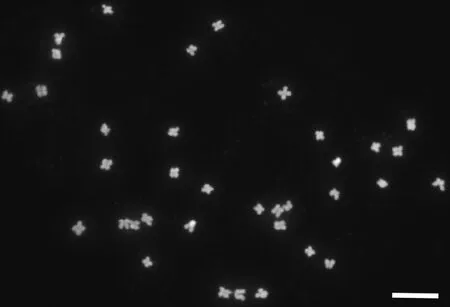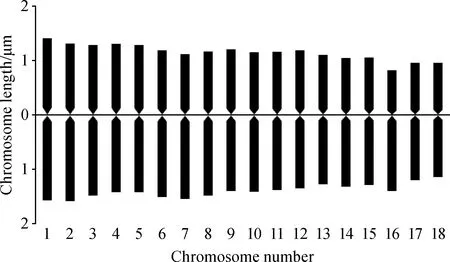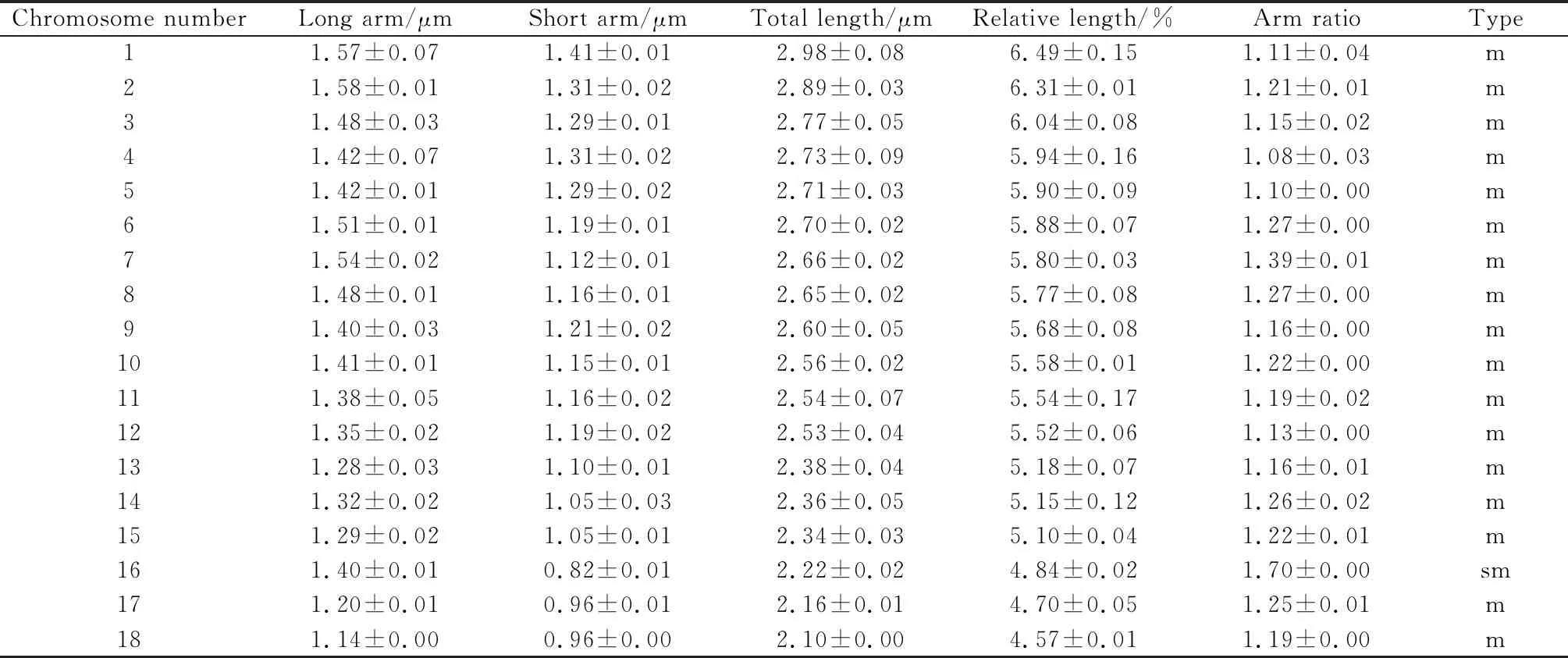Karyotype Analysis of Pennisetum centrasiaticum in Shigatse,Tibet
ZHANG Li-tian, LIU De-mei, LIU Bo,3, YANG Shi-hai, WANG Yan-long, WANG Xiao-li, MA Yu-shou*
(1. Academy of Animal Science and Veterinary Medicine, Qinghai university, Xining, Qinghai Province 810016, China;2. Northwest Plateau Institute of Biology, Chinese Academy of Science/Key Laboratory of Adaptation and Evolution, Chinese Academy of Science/Key Laboratory of Crop Molecular Breeding in Qinghai Province, Xining, Qinghai Province 810008, China;3. University of Chinese Academy of Science, 100049, Beijing, China;4. Tibet Yunwang Industrial Co., Ltd., Shigatse, Tibet 857000, China;5. Shigatse Baiyacheng Agricultural Products Processing Co., Ltd., Shigatse, Tibet 857000, China)
Abstract:Pennisetum centrasiaticum is widely distributed all over the world, and it is kind of forage grazed by cattle and sheep. In this study,a conventional squash technique was used to analyze the karyotype of P. centrasiaticum collected from shigatse. Results showed that the sum of chromosome lengths was 45.87 μm,the average arm ratio of chromosome was 1.23,and the index of karyotypic asymmetry was 54.83. All chromosomes with the arm ratio ranged from 1.08 to 1.70,one pair of chromosomes was sm,and the remaining chromosomes were m. There was no satellite on the chromosome of P. centrasiaticum. The basic chromosome number was 9,and P. centrasiaticum was a tetraploid plant with karyotype formula 2n=4x=36=34 m+2 sm,and belonged to Stebbins’ 1A type. It meant P. centrasiaticum was a primitive species in evolution.
Key words:Pennisetum centrasiaticum Tzvel.,Chromosome,Karyotype,Tibet Changes in chromosome structure and quantity play an important role in reproductive isolation between populations[1]. Karyotype is the phenotypic characteristics of chromosomes[2],and karyotype analysis is a basic method in cytogenetics research by observing the chromosome morphological characteristics of species following certain standards,pairing,numbering,and grouping chromosomes artificially[3]. Therefore,investigating karyotype of chromosomes is essential for studying plant evolution[2-6].
Pennisetumcentrasiaticumis a perennial herb growing mostly at hillside and dry place. It is an excellent forage with good nutritional value,and widely distributed in Heilongjiang,Jilin,Liaoning,Inner Mongolia,Hebei,Shanxi,Shaanxi,Gansu,Qinghai,northwest Sichuan,north Yunnan and Tibet of China[7]. Mehra and Sharma[8]reported the chromosomes number was 2n=18 inP.centrasiaticumcollected from Kashmir in the Northwest Himalayas. Mehra and Remanandan[9]found thatP.centrasiaticumhad two intraspecific races,diploid (2n=18) and pentaploid (2n=45) in Kumaon. Li[10]investigated karyotype and C-banding ofP.centrasiaticumcollected from the stallion station of Changling County,Jilin Province,and found that the chromosome number was 2n=2x=18=16 m+2 st. However,karyotype information onP.centrasiaticumis still scarce.
Therefore,we conducted the karyotype analysis ofP.centrasiaticumfrom Tibet using conventional squash technique. This would provide a theoretical basis for diversity protection and utilization ofP.centrasiaticumgermplasm resources.
1 Materials and methods
1.1 Plant materials
The seeds ofP.centrasiaticumwere collected from Aima Township (89°15′1″ E,29°26′17″ N;masl:4 010 m),Nanmulin County,Shigatse City,Tibet,China in October 2019. The matured seeds were placed on a petri dish with moist filter paper and germinated at 25℃. When the radicle grew to 10~15 mm,the root tips were cut off for the cytological study.
1.2 Chromosome preparation
The preparation of chromosomes at metaphase of mitotic was followed the methods of Lu[11]as below. The root tip ofP.centrasiaticumwas put into a 1.5 mL tube,the tube was kept open and moist,then treated the tube in a N2O gas chamber under eight standard atmospheres for 2 h. Five hundred microlitter Carnoy's fluid (anhydrous ethanol:glacial acetic acid=3∶1,volume ratio) was added to each tube at 4℃ for more than 30 minutes. The fixed root tip was put on a clean glass slide with a drop of 45% acetic acid and a cover glass on the top. The cover glass was taped gently with tweezers to disperse the root tip cells evenly,then heated on the alcohol lamp for a few seconds,press it down vertically with thumb. The morphological characteristics and chromosome number in scattered chromosomes with clear morphology were observed under a microscope. The glass slide was frozen in the -80℃ freezer for 1.5 h,and then removed the cover glass,stained the slide with DAPI (REF H-1200),and taken pictures using an Olympus fluorescence microscope under the ultraviolet channel.
1.3 Karyotype analysis
Five pictures of metaphase plates with good dispersion were selected,then the cutting,the homologous chromosome pairing,numbering and the karyotypes were completed by Adobe Photoshop CS5 software. Image J software was used to measure the length of each chromosome,and Microsoft Excel 2016 was used to draw the ideogram.
Karyotype analysis were conducted according to the standard protocol reported by Li and Chen[12],the position of the centromere was determined by the method of Levan[13],index of the karyotypic asymmetry (As. K%) was calculated by Arano[14]as follows.

The karyotype classification was conducted according to the standard set by Stebbins[15].
2 Results and analysis
2.1 Chromosome number of P. centrasiaticum
Thirty cells at metaphase of mitosis were counted,except for individual cells with 15,32,35 chromosomes,90% of cells possessed 36 chromosomes. According to the observation results,the chromosomes number ofP.centrasiaticumin Shigatse,Tibet was 2n=36. The chromosome phase ofP.centrasiaticumat metaphase of mitotic was shown in figure 1.

Fig.1 Chromosome phase of P. centrasiaticum at metaphase of mitotic
2.2 Karyotype of P. centrasiaticum
All 36 chromosomes were sorted in pairs and numbered according to the length of the chromosome from high to low as shown in figure 2. The idiogram for chromosome ofP.centrasiaticumwas shown in figure 3.

Fig.2 Karyogram of P. centrasiaticum

Fig.3 Ideogram for chromosome of P. centrasiaticum
The karyotype statistical results were shown in Table 1. The sum of chromosome lengths was 45.87 μm,the chromosome length ranged from 2.10 μm to 2.98 μm,the relative length ranged from 4.57% to 6.49%,the long arm length ranged from 1.14 μm to 1.58 μm,the short arm length ranged from 0.82 μm to 1.41 μm,and there was no satellite on the chromosome. All chromosomes with the arm ratio ranged from 1.08 to 1.70,one pair of chromosomes was sm,and the remaining chromosomes were m. The average arm ratio of the chromosome was 1.23,and the index of karyotypic asymmetry was 54.83. The ratio of the longest chromosome to the shortest chromosome was 1.42,and there was no chromosome with arm ratio greater than 2,the karyotype ofP.centrasiaticumin Tibet was asymmetry belonged to Stebbins’ 1A type.

Table 1 Chromosome parameters of P. centrasiaticum
3 Discussion
3.1 Chromosome number and ploidy of P. centrasiaticum
The experiment identified for the first time that the chromosome number ofP.centrasiaticumin Tibet was 36,which was the same as previously reported in sixPennisetumspecies[16-17]. However,Mehra and Sharma[8]found thatP.centrasiaticumcollected from Kashmir hills possessed 18 chromosomes. Mehra and Remanandan[9]also found thatP.centrasiaticumexisted in two intraspecific races,diploid (2n=18) and pentaploid (2n=45) in Kumaon. The karyotype of theP.centrasiaticumin Changling County,Jilin Province is 2n=18[10]. The differences in chromosome number ofP.centrasiaticumfrom different collection locations might be related to the environmental adaptation.
Swaminathan and Nath[18]reported that the basic chromosome numbers ofPennisetumwere 7 and 9,and somePennisetumwith the basic chromosome numbers 5 and 8 were also found in Africa. Li and Wu[16]pointed out that the basic chromosome numbers ofPennisetumwere divided into two categories:one was 7,such asP.americanum,2n=14,andP.purpureum,2n=28,56,21;the other was 9,such asP.alopecuroides,2n=18. Zhang[17]observed the chromosome of four strains ofP.longissimumvar.intermediumand found that they were tetraploid with the basic chromosome numbers of 9. Zhang and Kang[19]reported that the chromosome number ofP.langissimumvar.intermediumwas 2n=6x=54,and the basic chromosome number was 9. Followed this rule,P.centrasiaticumin Shigatse,Tibet should be classified as a tetraploid with the basic chromosome number of 9,and the karyotype formula was 2n=4x=36=34 m+2 sm.
3.2 Polyploidization of P. centrasiaticum and its adaptation to high-altitude areas
P.centrasiaticumcollected from Kashmir hills,Kumaon and Jilin Province of China is diploid and possesses a chromosome number of 18[8-10]. However,pentaploid (2n=5x=45) is also found in Kumaon[9],and tetraploid (2n=4x=36) in our research in Tibet of China. A large number of studies showed that the overall doubling of the genome was the main driving force for plant evolution. In angiosperms,the overall doubling of the genome occurrs once or multiple times in about 70% of species in their evolutionary history[20]. With high altitude and low oxygen content in air,vegetation is difficult to grow in Tibet. The results of this study showed thatP.centrasiaticumbelonged to tetraploid,which might contribute to its adaptation to the hard environment of high-altitude areas.
4 Conclusions
P.centrasiaticumcollected from Shigatse,Tibet in this study was identified as a tetraploid plant with the basic chromosome number of 9,and the karyotype formula was 2n=4x=36=34 m+2 sm,belonged to Stebbins’ 1A type,which meantP.centrasiaticumwas a primitive specie in evolution.

